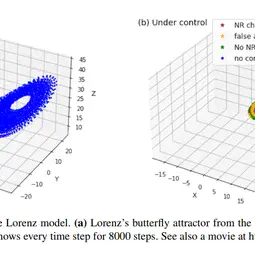Chaos to control: Scientists use a ‘butterfly attractor’ to control and change the weather
28 March 2022
MUNICH — Decades of global research have sparked the big question: can we really control the weather? According to a study published today in the journal Nonlinear Processes of Geophysics, this may soon be our new reality.
Researchers from the RIKEN Center for Computational Science have used computer simulations to show that extreme weather phenomena can be controlled and modified by making small adjustments to variables in the weather system. They did this using a system called a “butterfly attractor” in chaos theory, which has one of two states— just like the wings of a butterfly— and switches back and forth between the two states depending on small changes in certain conditions. The study’s findings promise multiple applications in the future, where weather events can be better controlled, including the effects of climate change.
The butterfly attractor was first proposed by mathematician and meteorologist Edward Lorenz, one of the founders of modern chaos theory. According to Lorenz, even the most minute, butterfly-scale changes to his computer weather models caused a range of weather outcomes from bright skies to raging storms, with no way to predict the final outcome. Since Lorenz first presented his study in 1972, his theory about the butterfly effect came to be widely popular and remains so even today. It includes the metaphor that a butterfly flapping its wings in Brazil can cause a tornado in Texas.
Designed ‘nature’ and weather control
The RIKEN team began to investigate Lorenz’s chaos theory to create realistic possibilities for mitigating weather events such as torrential rain. They ran one weather simulation to act as ‘nature’ itself (the control), and then ran other simulations using small variations in variables describing the convection—how heat moves through the system. They soon discovered that they could control ‘nature’ to stay in a chosen regime without shifting to the other, i.e., in a chosen wing of Lorenz’s butterfly attractor, by adding small changes to ‘nature’.
“We have successfully built a new theory and methodology to study the controllability of weather,” said Takemasa Miyoshi of the RIKEN Center for Computational Science, who led the research team. “Based on observing the system simulation experiments used in previous studies, we were able to design an experiment to investigate predictability, on the assumption that the true values (nature) cannot be changed, but rather that we can change the idea of what can be changed (the object to be controlled).”
A future with weather control technology?
Although weather predictions have reached high levels of accuracy thanks to supercomputer-based simulations and data assimilation, scientists have long hoped to be able to control the weather. Climate change has further intensified research in this area, because of the increased risk of extreme weather events like torrential rain and storms.
Takemasa says this study opens the path to research into the controllability of weather and could soon lead to weather control technology. “If realized, this research could help us prevent and mitigate extreme windstorms, such as torrential rains and typhoons, whose risks are increasing with climate change.”
Looking to the future, he says, “In this case, we used an ideal low-dimensional model to develop a new theory, and in the future, we plan to use actual weather models to study the possible controllability of weather.”
More information
All EGU journal articles are open access. When reporting on this story, please mention the name of the journal Nonlinear Processes in Geophysics, and, if reporting online, include a link to the paper or to the journal website: https://www.nonlinear-processes-in-geophysics.net/
Contact
Gillian D’Souza
Media and Communications Officer
European Geosciences Union
media@egu.eu
Author:
Dr. Takemasa Miyoshi
RIKEN Center for Computational Science, Japan
Email takemasa.miyoshi@riken.jp
Links
- Published paper
- RIKEN Center for Computational Science
- The Butterfly Effect
- A butterfly flapping its wings in Brazil can cause a tornado in Texas

